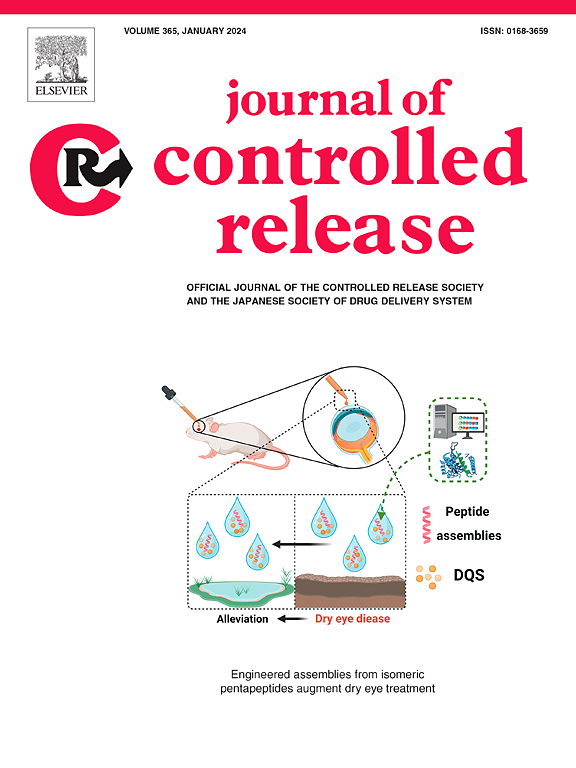Exosome-based mucosal therapeutic and diagnostic system: towards clinical translation
IF 10.5
1区 医学
Q1 CHEMISTRY, MULTIDISCIPLINARY
引用次数: 0
Abstract
The mucosa, as the body's largest immune organ, is involved in various diseases such as ulcerative colitis, respiratory conditions, and tumors. Mucosal delivery offers favorable patient compliance, strong localized therapeutic effects, and the ability to treat a broad spectrum of diseases. However, the multilayered barrier structure of mucosal tissues often hinders effective drug delivery. Although current nanotechnologies have demonstrated some success in overcoming mucosal barriers, they still encounter challenges such as immunogenicity, low stability, high production costs, and difficulties in clinical translation. Extracellular vesicles (EVs), natural nanoscale lipid bilayer vesicles found in plants, animals, microorganisms, and body fluids, possess high biocompatibility, low immunogenicity, targeted delivery, and an excellent capacity to cross biological barriers. Exosomes, a subtype of EVs, are emerging as promising bio-nanotherapeutic tools capable of addressing limitations that conventional nanoparticles cannot. Their cargo of nucleic acids and proteins enables both therapeutic and diagnostic functions across various diseases. Exosomes can effectively traverse mucosal barriers—including gastrointestinal, nasal, and ocular mucosa—thereby offering a potential solution to mucosal delivery challenge. Moreover, exosomes derived from mucosal secretions may serve as biomarkers for diagnosing mucosa-associated diseases, providing a non-invasive and easily accessible alternative to blood samples. This review aims to elucidate the therapeutic roles and mechanisms of exosomes from different sources as drug carriers or therapeutic agents in diseases treated via transmucosal delivery. It also summarizes the diagnostic potential of mucosal secretion-associated exosomes. In conclusion, this paper underscores the importance of exosomes in mucosal delivery, discusses their current limitations and future promise, and provides new insights into their clinical applications.


基于外泌体的粘膜治疗和诊断系统:走向临床转化
粘膜作为人体最大的免疫器官,与溃疡性结肠炎、呼吸系统疾病和肿瘤等多种疾病有关。粘膜给药具有良好的患者依从性,强大的局部治疗效果,以及治疗广谱疾病的能力。然而,粘膜组织的多层屏障结构往往阻碍有效的药物传递。尽管目前的纳米技术已经在克服粘膜屏障方面取得了一些成功,但它们仍然面临着诸如免疫原性、低稳定性、高生产成本和临床转化困难等挑战。细胞外囊泡(EVs)是天然的纳米级脂质双层囊泡,存在于植物、动物、微生物和体液中,具有高生物相容性、低免疫原性、靶向递送和跨越生物屏障的良好能力。外泌体是ev的一种亚型,作为一种有前途的生物纳米治疗工具,它能够解决传统纳米颗粒无法解决的局限性。它们所携带的核酸和蛋白质具有治疗和诊断各种疾病的功能。外泌体可以有效地穿越粘膜屏障,包括胃肠道、鼻粘膜和眼粘膜,从而为粘膜递送挑战提供了一个潜在的解决方案。此外,来自粘膜分泌物的外泌体可以作为诊断粘膜相关疾病的生物标志物,提供非侵入性和易于获取的血液样本替代方法。本文旨在阐明不同来源的外泌体作为药物载体或治疗剂在经黏膜给药治疗疾病中的作用和机制。本文还总结了粘膜分泌相关外泌体的诊断潜力。总之,本文强调了外泌体在粘膜递送中的重要性,讨论了它们目前的局限性和未来的前景,并为它们的临床应用提供了新的见解。
本文章由计算机程序翻译,如有差异,请以英文原文为准。
求助全文
约1分钟内获得全文
求助全文
来源期刊

Journal of Controlled Release
医学-化学综合
CiteScore
18.50
自引率
5.60%
发文量
700
审稿时长
39 days
期刊介绍:
The Journal of Controlled Release (JCR) proudly serves as the Official Journal of the Controlled Release Society and the Japan Society of Drug Delivery System.
Dedicated to the broad field of delivery science and technology, JCR publishes high-quality research articles covering drug delivery systems and all facets of formulations. This includes the physicochemical and biological properties of drugs, design and characterization of dosage forms, release mechanisms, in vivo testing, and formulation research and development across pharmaceutical, diagnostic, agricultural, environmental, cosmetic, and food industries.
Priority is given to manuscripts that contribute to the fundamental understanding of principles or demonstrate the advantages of novel technologies in terms of safety and efficacy over current clinical standards. JCR strives to be a leading platform for advancements in delivery science and technology.
 求助内容:
求助内容: 应助结果提醒方式:
应助结果提醒方式:


